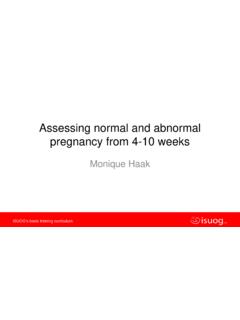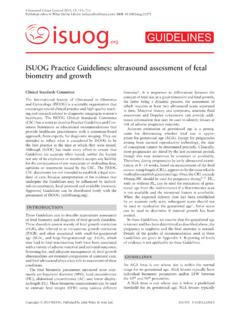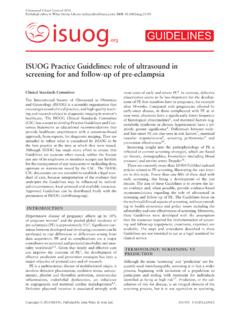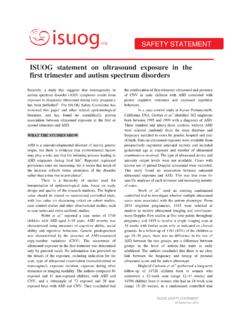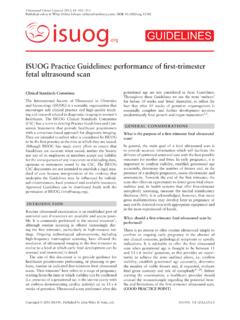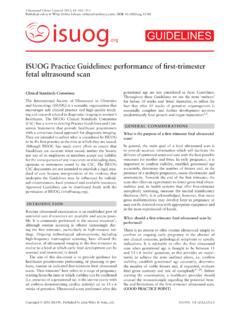Transcription of ISUOG Practice Guidelines: role of ultrasound in twin ...
1 ultrasound Obstet Gynecol2016;47: 247 263 Published online in Wiley Online Library ( ). Practice guidelines : role of ultrasound in twinpregnancyClinical Standards CommitteeThe International Society of ultrasound in Obstetricsand Gynecology ( ISUOG ) is a scientific organization thatencourages sound clinical Practice , and high-quality teach-ing and research related to diagnostic imaging in women shealthcare. The ISUOG Clinical Standards Committee(CSC) has a remit to develop Practice guidelines and Con-sensus Statements as educational recommendations thatprovide healthcare practitioners with a consensus-basedapproach, from experts, for diagnostic imaging.
2 They areintended to reflect what is considered by ISUOG to bethe best Practice at the time at which they are ISUOG has made every effort to ensure thatGuidelines are accurate when issued, neither the Societynor any of its employees or members accepts any liabilityfor the consequences of any inaccurate or misleading data,opinions or statements issued by the CSC. The ISUOGCSC documents are not intended to establish a legal stan-dard of care because interpretation of the evidence thatunderpins the guidelines may be influenced by individ-ual circumstances, local protocol and available guidelines can be distributed freely with thepermission of ISUOG incidence of multiple pregnancy is rising, mainlydue to delayed childbirth and advanced maternal age atconception and the resultant widespread use of assistedreproduction techniques1.
3 The twin birth rate increasedby just under 70% between 1980 (19 per 1000 live births)and 2006 (32 per 1000 live births) pregnancy is associated with a high risk of peri-natal mortality and morbidity3 6. In 2009, the associatedstillbirth rate was 12 per 1000 twin births and 31 per1000 triplet and higher-order multiple births, comparedwith five per 1000 singleton births7,8. Preterm birth priorto 37 weeks gestation occurs in up to 60% of multiplepregnancies, contributing to the increased risk of neonatalmortality (65% of neonatal deaths among multiple birthsare preterm, compared with 43% of neonatal deaths insingletons) and long-term morbidity9 12.
4 Of course, suchcomplications rise with a reduction in gestational ageat birth. In addition, compared with singletons, twinsare at increased risk of iatrogenic preterm delivery dueto the greater incidence of maternal and fetal complica-tions. The risk is significantly higher in monochorioniccompared with dichorionic pregnancy3 assessment of fetal biometry, anatomy,Doppler velocimetry and amniotic fluid volume is used toidentify and monitor twin pregnancies at risk of adverseoutcomes such as twin -to- twin transfusion syndrome(TTTS) and fetal growth restriction (FGR).
5 As in sin-gletons, impaired fetal growth can be assessed in twins bycomparing biometry and Doppler velocimetry parametersagainst standards for uncomplicated guidance will address the role of ultrasound inthe care of uncomplicated twin pregnancy and thosecomplicated by TTTS, selective FGR (sFGR), twinanemia polycythemia sequence (TAPS), twin reversedarterial perfusion (TRAP) sequence, conjoined twins andsingle intrauterine death (IUD). The document providesguidance on the methods used to determine gestationalage and chorionicity, screening for chromosomal andstructural abnormalities, and screening for TTTS, TAPS,growth abnormalities and preterm birth.
6 The manage-ment of higher-order multiple pregnancy will be coveredin a separate Dating of the pregnancy (determining gestational age) Determining chorionicity and amnionicity twin labeling Timing, frequency and content of ultrasound assess-ment Screening for aneuploidy Prenatal diagnosis of aneuploidy Screening for structural abnormalities Diagnosis and management of discordant twin preg-nancy Fetal reduction/selective termination Screening for preterm birth Screening, diagnosis and management of FGR Management of multiple pregnancy complicated bysingle IUDC opyright 2015 ISUOG .
7 Published by John Wiley & Sons S U O G G U I D E L I N E S248 ISUOG guidelines Complications unique to monochorionic twin preg-nancy Screening, diagnosis and management of TTTS Screening, diagnosis and management of TAPS Management of TRAP sequence Managementofmonochorionicmonoamniotic(MC MA) twin pregnancy Diagnosis and management of conjoined twinsIDENTIFICATION AND ASSESSMENTOF EVIDENCEThe Cochrane Library and Cochrane Register of Con-trolled Trials were searched for relevant randomizedcontrolled trials, systematic reviews and meta-analysesand a search of MEDLINE from 1966 to 2014 was car-ried out.
8 The date of the last search was 15 November2014. In addition, relevant conference proceedings andabstracts were searched. Databases were searched usingthe relevant MeSH terms including all sub-headings. Thiswas combined with a keyword search using twin , multi-ple , pregnancy , ultrasound , twin -to- twin transfusionsyndrome , fetal growth restriction , twin anemia poly-cythemia sequence , twin reversed arterial perfusion , acardiac twin , monochorionic monoamniotic , con-joined , demise . The National Library for Health and theNational guidelines Clearing House were also searchedfor relevant guidelines and reviews.
9 Gray (unpublished)literature was identified through searching the websitesof health technology assessment and health technologyassessment-related agencies, clinical Practice guideline col-lections and clinical trial registries. The search was limitedto the English language. When possible, recommendationsare based on, and explicitly linked to, the evidence thatsupports them, while areas lacking evidence are annotatedas good Practice points . Details of the grades of recom-mendations and levels of evidence used in these Guidelinesare given in Appendix of twin pregnancy twin pregnancies should ideally be dated when thecrown rump length (CRL) measurement is between 45and 84 mm ( 11+0to13+6 weeks of gestation)(GRADE OF RECOMMENDATION: D).
10 In pregnancies conceived spontaneously, the larger ofthe two CRLs should be used to estimate gestationalage (GRADE OF RECOMMENDATION: C).Other studies have recommended the use of the smallerCRL or the mean CRL, which takes into account bothfetuses13 15. The disadvantage of using the smaller CRLis the potential of the operator believing that the largertwin is large-for-gestational age, and therefore beingfalsely reassured that the smaller twin is still growingappropriately. The most common Practice is to use thelarger CRL. If the woman presents after 14 weeks gesta-tion, the larger head circumference should be conceived viain-vitrofertilization should bedated using the oocyte retrieval date or the embryonic agefrom fertilization (EVIDENCE LEVEL: 2+).
